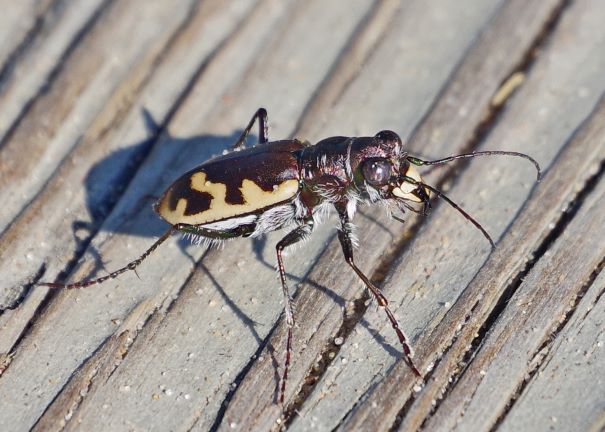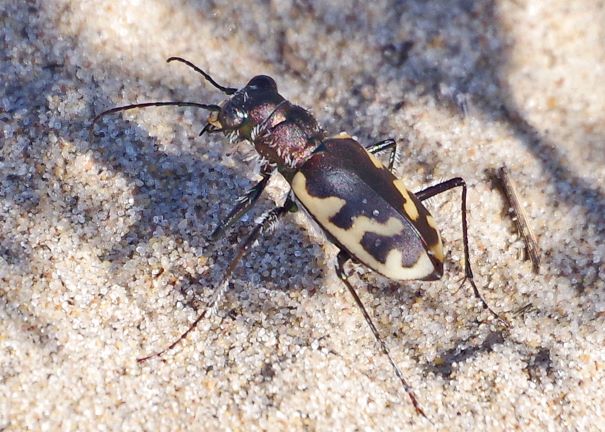
Big Sand Tiger Beetle
Howdy BugFans,
Last fall, BugFan Joanne told the BugLady about a fabulous tiger beetle she saw in the dunes at Kohler Andrae State Park, and the BugLady was determined to find one this year. Tiger beetles are a wonderful group in the Ground beetle family Carabidae. They’re varied and beautiful (and surprisingly cryptic); they’re unapologetic predators as both larvae and adults; and they have a bunch of very cool adaptations – big eyes, excellent eyesight, long legs, and massive jaws https://bugguide.net/node/view/2047252/bgimage – that allow them to live and hunt pretty much out in the open. Tiger beetles have a lot of fans. For Tiger Beetle 101, see https://uwm.edu/field-station/tiger-beetles-revisited/.
The Big Sand Tiger Beetle (Cicindela formosa) is in the tribe Cicindelini (the “Flashy Tiger Beetles”) and in the genus Cicindela (the “Temperate Tiger Beetles”) and its species name formosa means “handsome.” Big Sand Tiger Beetles are divided up into six subspecies, most of which occupy fairly small ranges that lie to the west of us (https://bugguide.net/node/view/8190/bgpage, click on the subspecies and then click on the Data tab above the pictures for range map) (and be sure to click on some of the pictures) (alert BugFans will note that bugguide.net shows only five subspecies, but Cicindela formosa gibsoni was recently split).
Big Sand Tiger Beetles (BSTBs) occupy a sizable chunk of real estate in the center of the continent. Oddly, although there’s plenty of apparently-favorable habitat from the Carolinas to Texas, BSTBs are not found there. Our local subspecies is Cicindela formosa generosa, also called the Eastern Sand Tiger Beetle (glamour shot https://bugguide.net/node/view/1481712/bgimage). As their name suggests, Eastern Sand Tiger Beetles (ESTBs) are found in sparsely vegetated, dry sandy areas, dunes, sandbars in rivers, pine barrens, blowouts, and roadsides in roughly the northeastern quadrant of North America https://bugguide.net/node/view/232879/data. They have little competition for these inhospitable habitats.

At about three-quarters of an inch long, they are big – the ESTB is the largest Cicindela species in the Upper Midwest. The background color can vary, as can the width of the pale, scroll-like markings on the elytra (wing covers) https://bugguide.net/node/view/740607/bgimage, https://bugguide.net/node/view/1588160/bgimage.
The BugLady couldn’t find anything about tiger beetle courtship, other than a comment that for all their excellent eyesight, males sometimes attempt to mate with other males and even with other species – not all of the cues they use to distinguish gender and species have been discovered by scientists (or indeed, by the beetles themselves), but they usually get it right https://bugguide.net/node/view/1984279/bgimage. Female tiger beetles lay one egg at a time, each in a carefully selected spot – BSTBs bury their eggs in the sand. Tiger beetle larvae https://bugguide.net/node/view/1277687/bgimage dig tunnels, and BSTB larvae dig the deepest tunnels of all tiger beetles – from one foot to more than six feet deep. In the Field Guide to the Tiger Beetles of the United States and Canada, Pearson, Knisley, and Kazilek, speculate that “Apparently the great depth of their burrows allows larvae to survive the winter below the frost line.” Depending on food supply and latitude, BSTBs may live two or more years; usually a long insect life span is spent mostly in the larval stage, but BSTBs may overwinter either as larvae or as adults. Look for them in May and June and again in August and September.
They eat small insects and spiders, which the adults chase and catch, and the larvae ambush from the shelter of their tunnels https://bugguide.net/node/view/1277194/bgimage. ESTBs are said to be particularly fond of ants (one field guide showed a picture of a tiger beetle with the detached head of an ant clamped to its antennae by the ant’s jaws), but adult ESTBs are big enough to attack insects as large as other tiger beetles.
Tiger beetle larvae in their tunnels are susceptible to the larvae of bee flies, and the BugLady did see several kinds of bee flies in the dunes. Female bee flies lob their eggs into the entrances of the tunnels that solitary bees, wasps, and tiger beetles dig to lay their eggs in, and when they hatch, the fly larvae hike down the tunnel and feed on the larvae they find there. Birds and robber flies feed on the adults, but they have to be quick.
Temperature control is critical for sand-loving species. ESTBs adapt to the hot surface of the sand partly by coloration – like many species of Tiger Beetles their underside is covered with white hairs https://bugguide.net/node/view/2047251/bgimage that deflect heat from below. They stand “on tiptoes” (“stilting”) to get farther from the heat, and they will face the sun (they have white upper “lips” https://bugguide.net/node/view/2047252/bgimage) to minimize the surface area exposed to its rays. They shelter in the vegetation at night, and, because of their size, it takes ESTBs longer to warm up and get out on the sand than smaller species.
FUN FACTS ABOUT ESTBs: In Tiger Beetles of Minnesota, Wisconsin & Michigan, Matthew Brust reports that “the adults are strong fliers, and perhaps due to their large size, emit an audible buzzing noise. Commonly fly 20 to 60 feet. Curiously, adults typically bounce or tumble when landing.” [Nota bene: Because they must hold their elytra out to the side when they fly in order to uncover the membranous flying wings (like a tiny bi-plane), beetles make lots of awkward landings.]
The BugLady recommends Brust’s book, not only because it is comprehensive and regional and gloriously illustrated, but because of its prose: “Males are apparently very protective of their paternity, and a behavior called contact guarding is commonly observed. In this case a male will remain coupled with a female (a male remains on the back of the female, using his mandibles to grasp her thorax) for some time after copulation so as to prevent another male from mating with that female and possibly removing his sperm. In some cases, the male may guard the female for up to an hour. It is common for females to actively hunt for prey while the male is still coupled. However, it seems the interests of the males and females are often very different. While the male is usually very concerned about protecting his paternity, the female typically seems more concerned with foraging and other routine behaviors. So while the male tries to remain coupled with the female as long as he can, the female will often use a variety of tactics to attempt to dislodge him. These female behaviors typically involve violent shaking initially, but if such tactics do not work, females will often run through dead vegetation in order to clothes-line the male. In extreme cases she may actually simply stop in a direction that points the male’s back directly at the sun, thereby cooking him off (the male will quickly overheat if he does not disengage).”
Kate Redmond, The BugLady
Bug of the Week archives:
http://uwm.edu/field-station/category/bug-of-the-week/
